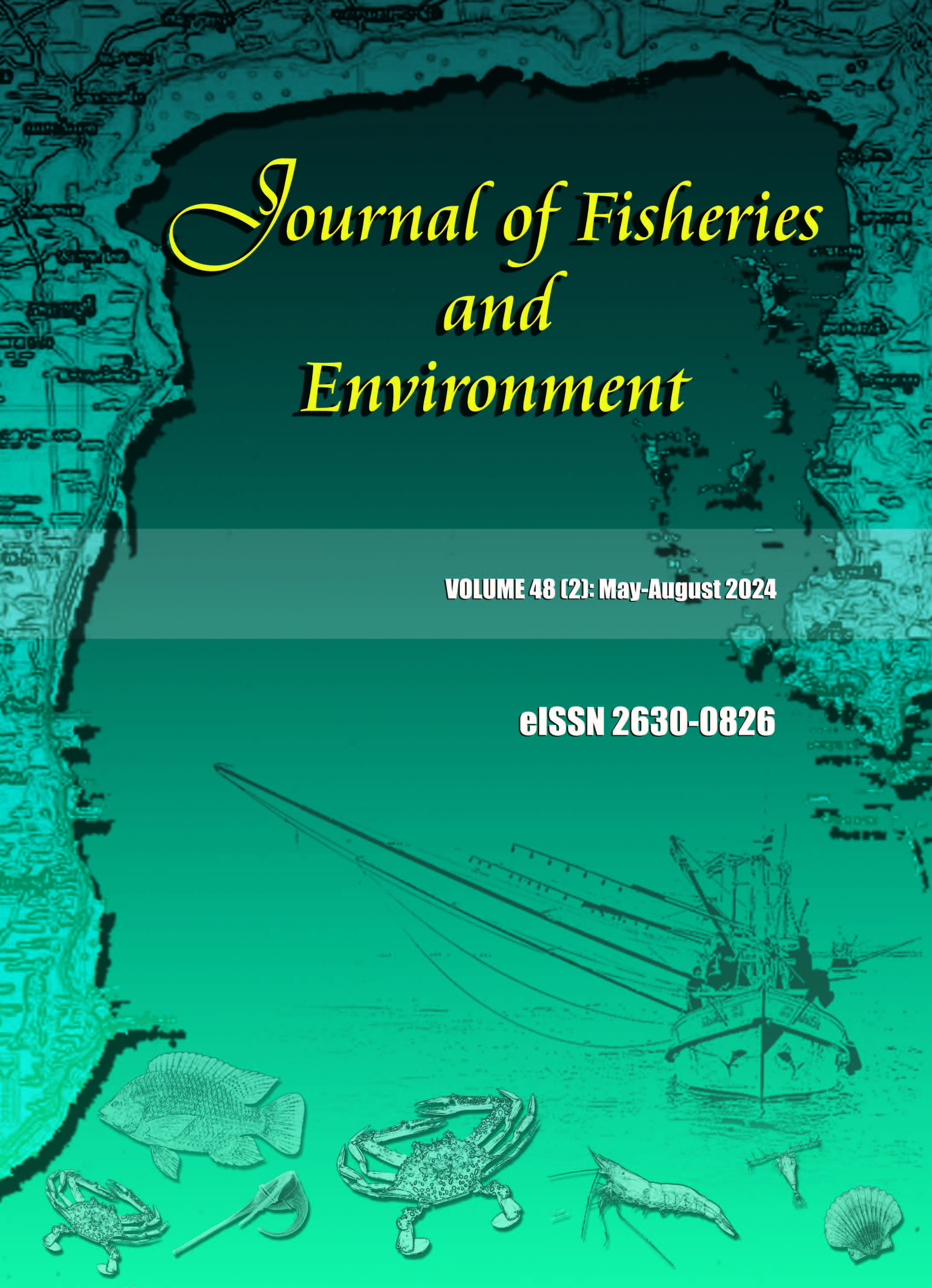Effects of Mixed Mineral Supplementation in On-Farm Feeds on the Metamorphosis Development and Growth Performances of Frog (Hoplobatrachus rugulosus) Tadpoles
Main Article Content
Abstract
The frog (Hoplobatrachus rugulosus) is widely cultured in Asian countries. Tadepoles in these cultures are prone to diseases and sensitive to environmental factors, but their metamorphosis and growth may be enhanced by applying minerals. Therefore, this study was conducted to determine the influence of mixed mineral supplementation in on-farm feeds on the metamorphosis development, growth performance, and production cost of H. rugulosus tadpoles. Four levels of mixed mineral supplementation (0%, 0.2%, 0.4%, and 0.6%) were fed to groups of 500 tadpoles stocked in cement ponds. Tadpoles were fed experimental feeds at 5% of their body weight for 35 days. The 0.2% supplementation group showed significantly greater average weight gain (3.84±0.15 g·tadpole-1) and survival rate (81.00±0.47%) compared to the 0.6% and 0% groups (p<0.05), but was comparable (p>0.05) to the 0.4% group. Notably, other growth parameters (average daily weight gain, specific growth rate, and feed conversion ratio) did not differ significantly (p>0.05) among treatments. The groups receiving mineral supplementation showed significantly (p<0.05) higher average forelimb length than the control from day 20 until day 28, but not from days 30 to 36. Conversely, mineral supplementation did not affect hindlimb length throughout the experiment. Tadpoles receiving 0.2% supplementation completed metamorphosis faster than other groups, starting on day 26 and reaching 100% completion by day 34. This study demonstrated that feeding 0.2% mixed mineral supplementation to frog tadpoles accelerated the metamorphosis and improved their growth, albeit with a slight increase in production costs.
Article Details

This work is licensed under a Creative Commons Attribution-NonCommercial-NoDerivatives 4.0 International License.
References
Association of Official Analytical Collaboration (AOAC). 1995. Official Methods of Analysis of AOAC International. Vol. I. Agriculture Chemicals; Contaminations, Drugs, 16th ed. AOAC International, Arlington, Virginia, USA. 1401 pp.
Association of Official Analytical Collaboration (AOAC). 2000. Official Methods of Analysis, 17th ed. Association of Official Analytical Chemists, Arlington, Virginia, USA. 2200 pp.
Brown, P.S. and S.C. Brown. 1973. Prolactin and thyroid hormone interactions in salt and water balance in the newt Notophthalmus viridescens. General and Comparative Endocrinology 20(3): 456–466.
Cabanilla-Legaspi, M.C., R.F.M. Traifalgar, E.G.T. de Jesus-Ayson, K.G.S. Andrino-Felarca, and R.E.P. Mamauag. 2021. Growth, metamorphosis, and survival of orange-spotted rabbitfish (Siganus guttatus) larvae fed sodium iodide-supplemented brine shrimp (Artemia sp.), Aquaculture 536: 736443. DOI: 10.1016/j.aquaculture.2021
.736443.
Christy, M.T. and C.R. Dickman. 2002. Effects of salinity on tadpoles of the green and golden bell frog (Litoria aurea). Amphibia-Reptilia 23(1): 1–11.
Department of Fisheries (DOF). 2021. Action plan for developing economically important freshwater species (2022-2024). https://www4.fisheries.go.th/local/index.php/main/
view_qr_group/131/9489. Cited 10 Apr 2022.
Fielder, D.S., W.J. Bardsley, G.L. Allan and P.M. Pankhurst. 2005. The effects of salinity and temperature on growth and survival of Australian snapper, Pagrus auratus larvae. Aquaculture 250(1–2): 201–214.
Goldstein, J.A., K.V.S. Hoff and S.D. Hillyard. 2017. The effect of temperature on development and behaviour of relict leopard frog tadpoles. Conservation physiology 5(1): cow075. DOI: 10.1093/conphys/cow075.
Gomez-Mestre, I., M. Tejedo E. Ramayo and J. Estepa. 2004. Developmental alterations and osmoregulatory physiology of a larval anuran under osmotic stress. Physiological and Biochemical Zoology 77(2): 267–274.
Haramura, T. 2007. Salinity tolerance of eggs of Buergeria japonica (Amphibia, Anura) inhabiting coastal areas. Zoological Science 24: 820–823.
Krishnapriya, M.V., C. Arulvasu, P. Sheeba, C.S. Sujitha and P.G. Neethu. 2014. Influence of elemental iodine and thiourea on metamorphosis of Philautus sp. Journal of Advanced Botany and Zoology 1(4): 2348–7313.
Nakkrasae, L., S. Phummisutthigoon and N. Charoenphandhu. 2016. Aquaculture Research 47(10): 3109–3118.
Nghia V.D., P.T.P. Lan and N.D.Q. Tram. 2023. Using black soldier fly larvae as feed for Thai frog (Rana rugosa Temminck and Schlegel, 1838)–Preliminary study of the effect on production parameters. Israeli Journal of Aquaculture–Bomidgeh 75(2): 89421. DOI: 10.46989/001c.89421.
Oofusa, K. and K. Yoshizato.1991. Biological and immunological characterization of collagenase in tissues of metamorphosing bull frog tadpoles. Journal of Development, Growth and Differentiation 33(4): 329–339.
Shi, Y.B. 2000. Amphibian Metamorphosis. From Morphology to Molecular Biology. Wiley-Liss, New York, USA. 288 pp.
Squires, Z.E., P.C.E. Bailey, R.D. Reina and B.B.B.M. Wong. 2010. Compensatory growth in tadpoles after transient salinity stress. Marine and Freshwater Research 61(2): 219–222.
Swingle, W.W. 1919. Iodine and the thyroid: III. The specific action of iodine in accelerating amphibian metamorphosis. The Journal of General Physiology 1(6): 593–606. DOI: 10.1085/jgp.1.6.593.
Uchiyama, M. and H. Yoshizawa. 1992. Salinity tolerance and structure of external and internal gills in tadpoles of the crab-eating frog Rana cancrivora. Cell and Tissue Research 267(1): 35–44.
Wilbur, H.M. and J.P. Collins. 1973. Ecological aspects of amphibian metamorphosis: nonnormal distributions of competitive ability reflect selection for facultative metamorphosis. Science 182(4119): 1305–1314.


